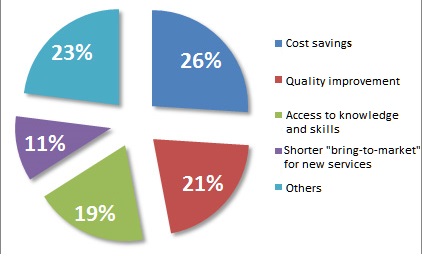IT as a driver
A company's ability to change plays a major role in determining its chances of survival, because it is the factor that differentiates them from the competition. As a CIO, you know better than anyone that IT is an important, if not the most important, business enabler. You also realize that change has a drastic impact on your IT organization, especially when conditions are changing faster and faster. The pressure on IT to align with the business is high, but IT must also be agile enough to evolve with the business and enable the change process. Otherwise the consequences can be disastrous.
The inability to change...
We are seeing an evolution where certain sectors and branches of industry feel threatened by so-called "disruptive newcomers". We've all heard of them: taxi companies that don't actually own taxis, but have a huge market share overnight. The Ubers and the Airbnbs, who are reshaping the traditional playing field of established values. They fully commit to the innovative potential of digitization and, in doing so, uncover the other companies' inability to change.
Shadow IT or managing your own destiny

The pressure isn't even necessarily external. Studies have shown that 63 percent of CIOs in the Benelux are dealing with pressure from within their own organization: departments go and buy their own IT products and services for which no official approval has been given and which the IT department knows almost nothing about. The main reason employees use this sort of "shadow IT" is that the IT department cannot meet the needs of the business. Trends like "bring your own device" (BYOD) and cloud computing are significant factors in this regard. The end effect is that CIOs, like you, are faced with a heterogeneous or even unmanageable IT landscape. Not to mention the security risks and the amount of time and money that has to be invested in these. Did you know that on average, 16 percent of IT expenditure is for shadow IT? Analysts do not expect this percentage to fall in the next few years, quite the opposite. You can accept diversity, but then you need a lot of skills to support that landscape. Alternatively, you can take back control of the situation, but then your IT department must have enough creative agility to effectively take over the role of business enabler.
Agility and the potential role for IT outsourcing
Agility is the key word, and it is doubtless something you are doing your best to achieve. However, you also know that skilled IT talent is scarce, so it is essential to deploy your talent properly. Do you use your people to maintain the status quo, or to create innovation? If you opt for the latter – which is the smart choice – you may be creating a bottleneck in the former. That is a good reason to think about outsourcing your IT – or at least a part of it, starting with your commodity IT: the computer landscape, the software, the servers, the security and so on. These are things that simply have to be there, and an external partner can take them off your hands by providing specialized services.
Here, the potential benefits of IT outsourcing go beyond the conventional reason for outsourcing, i.e. cost savings. By outsourcing the operational management of your IT environment to an external partner, you can focus on innovating your own IT environment in order to provide a platform that allows your business to grow. You can position your IT organization closer to the business, so it can respond better to the needs of the business and translate these into innovations faster.
Agility requires vision and strategy
No matter why you opt for IT outsourcing, you obviously want it to be successful. You are therefore well advised to position your IT outsourcing within a broader strategic perspective. What does IT mean for your organization now, and how does it fit with your future vision and your mission? How well does IT support your current business processes, and how flexibly can it deal with change and the potential complexity of change? By asking these questions, you will be in a better position to judge what you should keep in-house and what would be better implemented by outsourcing. It can be a good idea to get advice on these questions from external experts, without having to make a direct commitment to actual outsourcing.
Various methods are available to help you prepare your strategy for the business landscape and the supporting IT landscape. Gartner says that enterprise architecture is the foundation of a successful digital strategy, and rightly so. Enterprise architecture provides insight into the mutual relationships between the business model of your enterprise and the IT landscape. It identifies the current and future situations and ensures that the path between them is always aligned to your strategic business objectives. Enterprise architecture gives you the strategic road map that enables you to transform your organization, in a controlled and future-proof manner, from what it is now to what it should be.
'New priorities in a time of growth'

Reasons for outsourcing
IT outsourcing is not therefore something that stands alone, but rather is part of a broader vision of IT as a business enabler. Studies confirm the ever-increasing role of IT in the implementation of the strategic growth plans of enterprises. They show that the demand for IT outsourcing for these purposes is continuing to grow. For example, a study by Whitelane Research in 2015 showed that 46 percent of the 1,416 respondents intended to outsource more in the next few years, while 36 percent of companies did not expect any change in their spending budgets. Only nine percent said they would be spending less. Twelve percent did not know.
This growing trend of IT outsourcing is confirmed by KPMG's eighth "Service Provider and Performance Satisfaction" study, although it also identifies a significant shift in emphasis in the value proposition for this, which KPMG calls "new priorities in a time of growth". The economy is starting to flourish, so enterprises are focusing on growth again. Now that the crisis appears to be over, they are willing to loosen the purse strings and invest in transforming their business and making it agile. They will do this with IT as the primary facilitator, with the outsourcing emphasis gradually shifting from cost savings to providing services and innovations with added value for the business. The KPMG study also shows that along with cost savings (26%), more and different drivers for outsourcing are emerging: improving quality (21%), access to knowledge and skills (19%) and a shorter time to market for new services (11%).
 Want to learn more about IT outsourcing? If so, contact Jo Leemans, Sales & Governance Manager IT Outsourcing RealDolmen.
Want to learn more about IT outsourcing? If so, contact Jo Leemans, Sales & Governance Manager IT Outsourcing RealDolmen.
This blog post is the first in a biweekly series of eight about IT outsourcing.
In the next blog post, we will discuss the impact of IT outsourcing on your company.
Want to learn more about IT outsourcing? Read also our other ITO blog posts:
Disruption is a fact: use IT outsourcing to reinforce your company's ability to change
You know the cost of IT outsourcing, but do you know its value?
Business continuity is the basis of every healthy company
In-house technology management is shifting to usage-base IT management. Are you ready for this? A checklist.
The cloud: the final hurdle on your way to IT Outsourcing?
If you want something done right, do it yourself - or maybe not?

